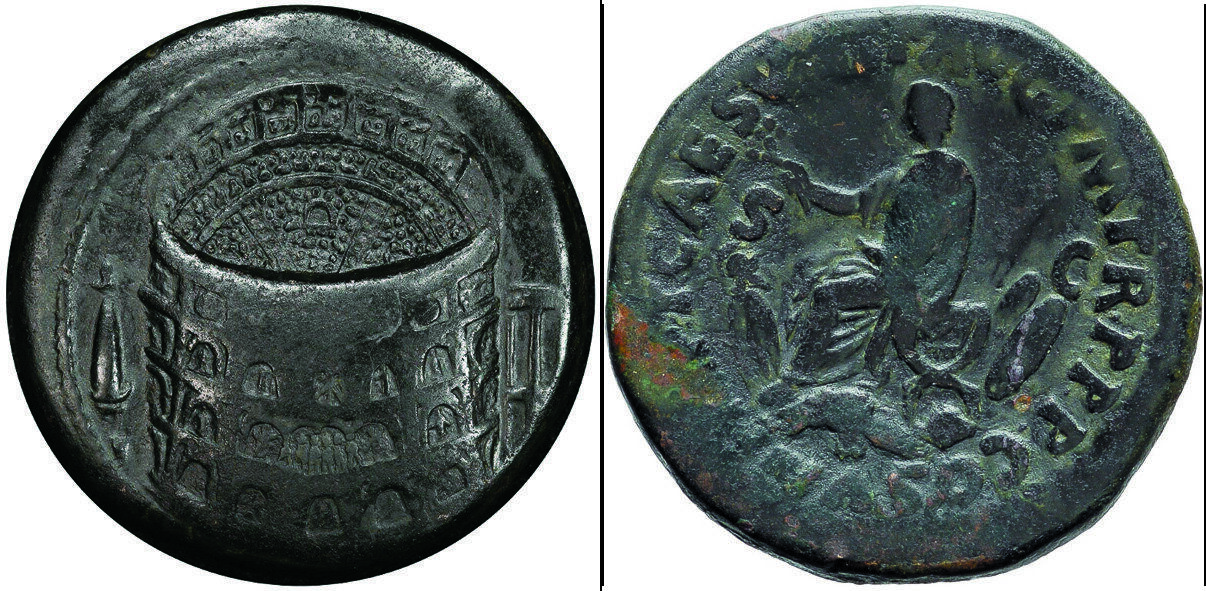S 115 - Rome (Titus), sestertii (80-81 CE)
From SILVER
80 CE - 81 CE Bronze
Description
| ObverseInscription or printing placed on the obverse.: | Colosseum seen from front and above between obelisk on base (Meta Sudans) and porticoed building of two stories (Baths of Titus), without legend |
| ReverseInscription or printing placed on the reverse.: | IMP T CAES VESP AVG P M TR P P P COS VIII (SC) (Latin).Titus seated l. holding branch and roll on curule chair set on globe among arms. |
Mint and issuing power
| MintIdentifies the place of manufacture or issue of a numismatic object.: | Rome | Ancient regionAncient region.: | Latium | Modern countryModern country: Italy | AuthorityIdentifies the issuing power. The authority can be "pretended" when the name or the portrait of X is on the coin but he/she was not the issuing power. It can also be "uncertain" when there is no mention of X on the coin but he/she was the issuing power according to the historical sources: | Titus (Roman emperor, 79-81 AD) |
Chronology
| FromIdentifies the initial date in a range assigned in a numismatic context. | 80 CE | toIdentifies the final date in a range assigned in a numismatic context.. | 81 CE | PeriodTime period of the numismatic object.: Roman from 30 BC |
Physical description
| MetalThe physical material (usually metal) from which an object is made.: | Bronze |
Median weightMedian of the weights of numismatic objects (in grams). in grams | 25.00 | DenominationTerm indicating the value of a numismatic object. Examples: tetradrachm, chalkous, denarius.: | sestertius | StandardStandard.: |
Image

S 115 - Rome (Domitian), sesterces (80-81 BCE).jpg [1]
References
| Die study referencePublication of the study: | Elkins 20061Elkins 2006 | ||
| Coin series referenceReference to coin series study: | RIC II.12RIC II.1, n° 184 | ||
Obverse dies distribution
no distribution is available
Reverse dies distribution
no distribution is available
Quantification
| Number of obversesNumber of obverse dies. ᵖ (o) | 4 | Number of singletons (o1)The number of singleton coins. ᵖ | |
| Number of reverse diesNumber of reverse dies. (r) | 6 | Number of coinsNumber of coins. (n) | 32 |
| Coins per obverse dieNumber of coins per obverse die. (n/o) | 8 | Coins per reverse dieNumber of coins per reverse die. (n/r) | 5.33 |
| Reverse per obverse ratioRatio of obverse dies divided by reverse dies. (r/o) | 1.5 | Percentage of singletons (o1)number of coins (n) divided by the number of singletons (o1) ᵖ | % |
| Original number of dies (O) (Carter 1983 formula)The estimation of the number of coins according to Carter 1983 ᵖ | 4.15 | Coins struck if 20,000 as average productivity per dieCoins made if the average productivity for obverses (according to Carter) is 20,000. ᵖ | 83,000 |
| Original number of dies (O) (Esty 2011 formula)The estimation of the number of coins according to the singleton formula in Esty 2011 ᵖ (O) | 4.57 | Survival rate if 20,000 as average productivity per dieSurvival rate if average productivity is 20,000. ᵖ | 0.00039 |
| Coverage (o = % of O) (Esty 1984 formula)Esty 1984 - coverage (% of O) ᵖ (o = % of O) | % | Die productivity if survival rate 1/2,000Average productivity if survival rate is 1/2,000. ᵖ | 15,421.69 |
| Weight of silver (in kg) if 20,000 coins per die (O = Carter formula)Carter 1983 * Median weight * 20000 (*10 if gold or electrum) ᵖ | n.a. | Die productivity if survival rate 1/5,000Average productivity if survival rate is 1/5,000. ᵖ | 38,554.22 |
Remarks
Most likely one single workstation